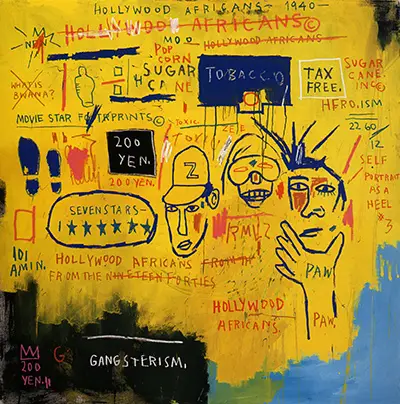Basquiat died in 1988 of a heroin overdose, aged just 28 years old, but by this time he had become famous in the US and beyond, both for his paintings and drawings which he exhibited in galleries and for his graffiti and street art.
Basquiat forged friendships with many leading figures of the US art scene, including the pop artist Andy Warhol, with whom he collaborated over 100 times.
Pop Art and popular culture were strong influences in Basquiat's work, however he also had his own unique style that is instantly recognisable as 'Basquiat'. It may be said that Basquiat's drawings, like this one which has long been exhibited in the Whitney Museum of Art, brought street art to the galleries and introduced it to new audiences.
Hollywood Africans was created using acrylics and oil stick on canvas, and this gives it the glaring, vivid even lurid feel that typified Basquiat's work. Another painting by Basquiat that utilises very vivid colours, for instance, is his work 'Untitled (Fallen Angel)'.
Hollywood Africans integrates words and drawings in a way that is, also, typical of a lot of Basquiat's work. His street art was very epigrammatic, whilst a later drawing, 'Riddle Me This, Batman' similarly used plenty of text that added meaning to Basquiat's drawings of popular figures like Batman, Robin and the Joker from the Batman comics.
Hollywood Africans mixes positive messages with more stereotypical ones. It resembles a billboard advert for a film, which has been awarded 'seven stars', but the word 'Gangsterism' is also written along the bottom left of the painting.
What looks like an advert for 'Tobacco' is also included prominently in this drawing. This reference to popular cultures of consumption and consumerism is something that crops up rather regularly in Basquiat's work.
For instance, his piece entitled 'Pez Dispenser' drew on the popularity of Pez candy in the US at the time, and particular the plastic dispensers shaped like famous characters from popular culture in which this candy was sold.


